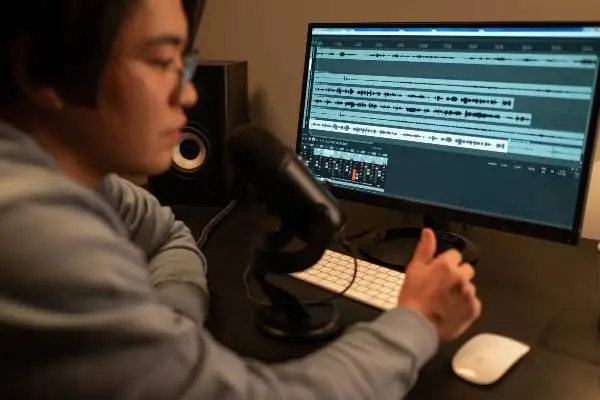A great vocal sound can easily make or break a track. On the contrary, a poor lead vocal can minimize the effect of an otherwise well-produced track. There's no debate. When it comes to audio production, crafting a cohesive vocal track is essential if you want to craft a professional sound.
While the art of processing vocal tracks is somewhat subjective, there are a couple of essential techniques every audio engineer takes into account while vocal processing. Below, we'll share how you can achieve that polished, professional vocal sound throughout the recording and mixing process.
8 Tips For Recording Professional Vocals
A strong mix can help a vocal sound expensive and polished, but without a great vocal recording , there's no way to achieve that professional sound. Here are some essential tips for recording strong vocals in the studio or from home.
1. A professional vocal starts with a great recording.
2. Different vocal styles require different types of microphones.
3. Don't be afraid to re-record if needed.
4. Get more takes than you need.
5. Encourage directed experimentation.
6. Protect your equipment.
7. Stay digitally organized.
8. Think about your environment.
1. A professional vocal starts with a great recording.
There's no denying that any professional track starts with a great recording. While this isn't necessarily an actionable piece of advice, it's essential to give the recording process the amount of attention it truly deserves.
Sure, you might be able to clear up some background noise during the mixing stage, or even use a boost and sweep technique to eliminate some imperfections across the frequency spectrum. That being said, remember that the less editing you have to do while mixing vocals, the better. Aim to create radio-ready vocals from the very beginning.
It's much easier to correct stylistic and timing issues while you're in a recording phase than attempting to do so after the fact. Recognize that each recording session needs to be approached independently.
For instance, you may need to adjust your vocalist's position throughout a session due to the proximity effect. You might need to spend more time recording takes than you originally accounted for. Whatever it may be, take the time to do so since great vocals are essential to every great song.

2. Different vocal styles require different microphones.
Remember that every vocal is different. Hence, it makes sense that different types of vocals would require different microphones. You don't necessarily need boutique microphones to get a great recording, but you should understand your equipment inside and out.
Generally speaking, condenser microphones sound relatively brighter and may have a bit of a top-end boost. You might be able to hear more of the low end or low mids on a ribbon microphone, for example, which has a flatter, more consistent signal and less of an exaggerated top end. These microphones are also much more sensitive than condenser microphones and require different upkeep considerations.
Dynamic microphones are some of the sturdiest microphones you can find, making them potentially great choices for more aggressive vocal deliveries. Just make sure that you truly understand the equipment you're using to preserve your equipment and quality of the voice recording.
3. Don't be afraid to re-record if needed.
There's nothing shameful about taking a step back from the mixing process and re-recording vocals. Oftentimes, this is the preferred approach as it is much easier to fix issues across the frequency spectrum in the recording phase than further along in the process.
Getting a great voice recording can also be dependent on the state of the vocalist. When you're tired or unprepared, it definitely shows up on the microphone. If you're recording your own tracks, make sure you get plenty of rest before recording. When tracking vocals, have plenty of water nearby so that you can stay hydrated. It may not seem all that important, but there's no plug-in that can recreate the energy and performance of a well-crafted vocal.
If you find yourself struggling while mixing vocals, don't forget that there's always the option to take a step backwards if needed. The more you record, the more you're able to perfect your technique and notice what you need to improve on most. Be honest with yourself and your recordings, and the work will shine through.
4. Get more takes than you need.
It's always best to get more vocal takes than you need rather than less. As a general rule of thumb, get all the takes you were hoping to get, plus one or two more. That way, you'll have more variations to choose from while selecting your pivotal main vocal.
As the recording engineer, you'll also want to take mental note of where there might be a mistake or unwanted sounds in the vocals. You'll need to direct your vocalist so that you re-record these takes properly, which will make the mixing engineer's job much easier.
Also, don't forget to listen back with the artist. They may have a different idea on where the most important part of the vocal sits or an option on how the dynamics are being delivered. Work with your vocalist in tandem. If not now, they're sure to let you know during the mixing stage.
5. Encourage directed experimentation.
Some voice artists are able to hop on the microphone and deliver polished, full takes without breaking a sweat. Other less experienced vocalists may need a bit more direction and potentially encouragement, so be sure to offer positive affirmations in abundance.
Remember, you aren't just there to press the "record" button. You are essentially the vocal director who's in charge of the room sound, processing, and most importantly, helping the vocalist give their best performance.
Offer encouragement while recording vocals and help your vocalist go beyond their usual comfort zone. Once you get the main vocal takes you need, maybe suggest that the vocalist sings with a different tone or energy level. You might not end up using these more experimental takes, but layering them could add some extra nuance, elevating a mix. Experiment with different dynamics, mic choices, and even a separate room tone to get the most out of your session.
6. Protect your equipment.
Without proper equipment, there's no way to get a great vocal recording. Don't neglect the importance of equipment upkeep, especially with your microphones. In fact, popular microphones like condenser and ribbon mics all have extremely sensitive hardware. Any bumps or damage to the diaphragm of the microphone could render it unusable.
To reduce the risk of damaging your microphones, make sure you store them properly after every session. Leaving a microphone out on a mic stand opens up the risk for it falling over. It's simply not worth the risk. Never place your microphone in a spot where it could become easily knocked over or damaged. For that matter, treat the rest of your equipment with respect too. Cables that are well maintained and coiled last a lot longer and are more likely to perform better than one just thrown into a drawer.
Taking the time to protect your equipment won't just produce better recordings, it will save you money in the long run. Always default to the manufacturers' care instructions for the specifics on how to care for your equipment, and stick to it. If you're a traveling engineer or producer, make sure to label your gear, too. It's easy to get mixed up when going from one studio to another.
7. Stay digitally organized.
There's nothing worse than receiving a bunch of unlabeled files as a mixing engineer. Even if you're mixing your own tracks, take the time to label each vocal and background vocal accordingly. On the same principle, take notes during your recording session.
If a vocalist records a section in a particularly intriguing way, be sure to write that down. You'll certainly thank yourself later. It's easy to forget which sections you enjoyed the most through the recording process, and this habit can be particularly helpful if you're handing off the vocals to another engineer.
Also, don't forget to go through the technicalities of saving your tracks properly and backing them up on a hard drive and cloud drive. Vocal files are especially important to have a good grasp over since they're one of the only parts of the process that is challenging to manage remotely. Organize your recording session file so that anyone could pick up where you left off and understand which track is which just by looking at it.
8. Think about your environment.
When it comes to producing studio-quality vocals, a great microphone and mic placement is half the battle. You also want to think about the room sound, and how the treatment (or lack thereof) can bleed into your recording.
Generally speaking, you want your recording space to sound as "dead" as possible. This means that your microphone shouldn't pick up excess information, including echoes and reverbs. You should be able to clap in a room, and not hear any echo or delay in noise. Sure, you could use a noise gate plug-in to help keep out unwanted noise but this can only go so far.
Invest in some level of acoustic treatment and do what you can to remove resonances before your vocalist is on location. In a pinch, you could use blankets and other furniture to help seal the sound. Stay away from recording in places where there's plenty of spots for the sound to slip through or reflect off of. For example, you wouldn't want to record in a space with lots of walls or windows.

9 Tips For Mixing Professional Vocals
Once you understand the proper way to record vocals, it's time to move onto the mixing stage. This process is just as important as recording since a mix helps your vocal sit properly in context with the rest of the tracks. Here are 9 tips for crafting a polished vocal mix .
1. Focus on cleanup first.
2. Take your time with comping.
3. Pitch correction isn't cheating.
4. Color your sound.
5. Utilize dynamic processing and compression.
6. Don't underestimate the power of space.
7. Make sure all layers are synchronized.
8. Add a little shimmer.
9. Give your ears time.
1. Focus on cleanup first.
Before adding any effects, picking out your favorite plugin, or adding those shiny EQ boosts , it's best to do as much manual clean-up as possible. This means lowering the gain of the loudest peaks, cutting out any unwanted noise or breaths, and using the EQ to soften harsh plosives like obvious consonants, "S" and "T" sounds.
It's also good practice to do as many subtractive EQ processes as possible before programing the rest of your signal chain since any unwanted noises will be amplified the further they are placed down in the plugin chain.
The EQ alone is an extremely versatile and powerful tool. In terms of subtractive processes, your EQ can help cut down on frequency buildup in common problem areas in mid and low frequencies. Later on in the process, you can use your EQ for more additive processes such as using a high shelf to highlight the upper mids or calling attention to new harmonics through a boost in targeted areas.
Generally speaking, your EQ cuts should be fairly subtle, usually nothing more than 3 dB. If you find that you have to make more drastic EQ cuts, you may need to consider returning to the recording phase. That being said, you should trust your ears above all else. If it's too overwhelming to look at a multi-band EQ, you might find it useful to use an analog modeling EQ which will in turn force you to rely on your ears above anything else. During the subtractive EQ phase , you can also use a de-esser to cut down on the harsh sibilance sounds. Take your time while cleaning up your vocals, since this will serve as the foundation for the rest of your mix.
2. Take your time with comping.
While you're scrubbing through the vocal takes, make sure you refer back to any notes you recorded during the tracking phase. Crafting a good vocal comp can take a lot of time, so make sure that you don't rush yourself through this process. Listen back to your takes one section at a time, and listen again.
When you finish creating your main comp, don't just delete the unused vocals. If it doesn't take up too much space or CPU in your session, you might as well keep the files in there. You never know, you might end up using an unused take as a backing vocal or as part of a vocal chop. If the excess vocals are taking up too much energy or space in your session, make sure you save them in a separate session before removing them from your current mix.

3. Pitch correction isn't cheating.
You might have heard that using any form of pitch correction is cheating. This couldn't be further from the truth. Even the best vocalist may utilize a little bit of autotune or pitch correct on a backing or main vocal, simply because a polished, tuned vocal sound is essential to today's pop sound.
The human voice is incredibly unpredictable, and while pitch correction shouldn't (in most cases) change the character of a vocal, it can certainly help polish the vocal and get rid of problematic frequencies that may interfere with the rest of the mix.
There are plenty of pitch correcting plugins that help your vocals sound tuned without being overly obvious. Though, nowadays, the "autotune" sound is embraced more than ever. With genres like trap and hyper pop embracing unabashed pitch correction, how much you use is simply up to personal taste.
Just remember that there's nothing shameful about tuning your vocals. If anything, tuning your vocals is an essential step to a cohesive vocal mix in most popular genres of music.
4. Color your sound.
When processing your vocals, it's essential to maintain lots of energy from the original vocal performance. However, weighing your plugin options is essential since even a handful of effects can add plenty of color and character to your vocal performance, and even help a vocal sound fit more naturally within a mix.
For example, genres like hip hop, rap , rock, and metal sometimes use distortion to add depth to a vocal. Most vocals use some sort of reverb as well. You'll want to consider using tools such as reverb , delay, distortion, saturation, and even chorus to help color your vocal.
5. Utilize dynamic processing and compression.
Dynamic processing plugins are far superior to traditional stock plugins since they adapt to the individual dynamics of a current sonic moment. That means that as the dynamics adjust, your plugin adjusts right along with it. This gives you more control over the vocal, and oftentimes, prevents you from over-compressing your lead recordings.
If you don't have a dynamic compressor, you can use a vocal rider to perform gain automation for dynamic compression. At the very least, you can use multiband compression to target certain parts of your mix rather than dampening the entire vocal.
Even if you don't have a multiband compressor , it's still essential to utilize vocal compression to even out the energy of your vocal. You should aim to produce no more than 2 to 3 dB of gain reduction. Some producers may prefer utilizing parallel compression processing, especially with vocals, since it gives your sounds an extra element of control.
6. Don't underestimate the power of space.
Remember, the absence of a vocal can be just as powerful as a vocal. Thinking about the absence of a vocal is important since it can help create contrast throughout the dynamics of your song, allowing you to build sonic energy without bringing up the gain too loud. Consider where it might be best to let other parts of the song shine in absence of the main or supporting vocals.
7. Make sure all layers are synchronized.
Timing issues are one of the greatest telltale signs between an amateur and professional mix. Take the time to listen to vocal groupings individually and adjust as needed. At the same time, it is possible that you might want to keep some of the original timing to preserve some of the live energy, but do not use this as an excuse to avoid properly aligning your tracks.
In most cases, vocals should be lined up word for word, especially in cases regarding background vocals and harmonies : These supplementary vocals need to be as cohesive as possible so that they don't distract from the lead vocal part. If you can't fix the timing issues with basic sound comping and volume automation, it may be time to re-record some of the audio in your mix.

8. Add a little shimmer.
Want a little more presence to your vocal mix? Simply boost targeted frequencies in 4.5 kHz to 9 kHz range with your EQ. While not every vocal needs this, adding a subtle bump around the high end of the frequency spectrum can give the vocal a bit more of a lift, especially in pop-style vocals. You can also use other plugins and a stereo widener to give your vocals more stereo width, or even experiment with pitching or panning can help create interest across your audio tracks.
9. Give your ears time.
Don't underestimate the power of ear fatigue over the sound of your mix. Whether you're a guitar player, producer, composer, or anything in between, our ears naturally lose perspective after listening to a sound mix for hours on end.
In order to create a great vocal mix or a great mix in general, you aren't just utilizing visual tools like a spectrum analyzer: You need to rely on your ears as the end all, be all of your project. Therefore, take time in between mixing sessions, and save your project as a new file every time you set up a new session. You'll be surprised how different your original mix sounds from your final master. These are all normal parts of the process, so trust yourself to take the time you need to make a great recording.
Creating state-of-the-art vocals can certainly take a lifetime to master. That being said, like anything else, practice makes perfect. If you're willing to take these essential recording and mixing tips in stride, you'll be well on your way to producing radio-ready vocals. Happy recording!





